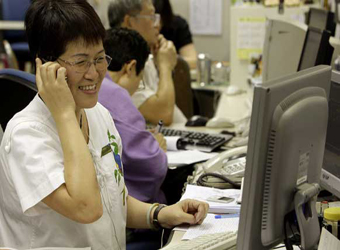Markets were mostly higher on Thursday after U.S. Federal Reserve May meeting minutes indicated an unwinding of its balance sheet likely towards year-end and as investors look ahead to an OPEC gathering widely expected to extend output cuts.
Minutes released yesterday indicated that the Fed could use a system where cap limits are implemented on how much the Fed would roll off every month without reinvesting. The central bank’s balance sheet is currently worth $4.5 trillion.
While the Fed signaled that interest rates could be raised soon, Federal Open Market Committee (FOMC) members also indicated in the minutes that it would be prudent” to wait for more evidence that reflected the softer economic data out of the U.S. recently was transitory. National Australia Bank Economist Tapas Strickland said in a Thursday morning note that the trajectory for interest rates after the likely June hike were “slightly more uncertain” due to inflation outlook from the Fed.
National Australia Bank Economist Tapas Strickland said in a Thursday morning note that the trajectory for interest rates after the likely June hike were “slightly more uncertain” due to inflation outlook from the Fed.
The dollar fell while stocks rose following the release of the minutes. The dollar index, which measures the dollar against a basket of rival currencies, traded as low as 97.093 after the news.
“A modest post-release fall in the dollar suggests messaging from the Fed was slightly less hawkish than some feared,” CMC Markets Chief Market Strategist Michael McCarthy said.
The dollar index sank to 96.916 at 11:55 a.m HK/SIN.
The Nikkei 225 gained 0.46 percent while South Korea’s benchmark Kospi index jumped 0.78 percent.
Down Under, the ASX 200 was steady, edging higher by 0.1 percent.
Markets in greater China were mixed a day after Moody’s downgraded the credit rating of the world’s second largest economy. Hong Kong’s Hang Seng Index was up 0.6 percent while the Shanghai Composite reversed earlier losses to gain 0.39 percent. The Shenzhen Composite shed 0.65 percent.
Indonesian markets were closed for a holiday.
Markets are also likely to be watching the highly-anticipated OPEC meeting in Vienna. Major oil producers are expected to extend, and potentially deepen, output cuts in a bid to rebalance bloated oil markets.
While U.S. West Texas International (WTI) crude will likely gain if output cuts are extended, FXTM Research Analyst Lukman Otunuga said oil prices remained caught between optimism over the OPEC-led deal and U.S. shale limiting upside gains.
“I believe that U.S. shale is a significant threat to the OPEC deal, especially when considering how the surging output from the U.S. has seized market share from other OPEC members … While it may be too early to say that this is the end of OPEC, U.S. shale has considerably weakened the cartel’s grip on the global markets,” Otunuga said in a Wednesday note.
Oil prices were higher ahead of the upcoming meeting. U.S. crude was added 0.72 percent to trade at $51.73 a barrel while Brent crude rose by 0.76 percent to $54.37.
Hong Kong’s rating was downgraded by Moody’s to Aa1 from Aa1 yesterday. This followed the rating agency’s downgrade of China’s credit rating for the first time since 1989. Moody’s said the Hong Kong downgrade was due to the impact of China credit trends on Hong Kong.
In South Korea, SK Hynix said the company’s chip foundry business would be spun into a separate company. A company spokeswoman told CNBC that the company had made the decision to “elevate the long-term competitiveness of the foundry business.”
After Samsung, SK Hynix is the world’s second largest chip maker. Shares of the company were up 0.9 percent.
Over in China, brokerages Citic Securities, Haitong Securities and Guosen Securities were fined by regulators for violating financing rules. The mainland-listed shares of the brokerages reversed earlier losses to trader higher. Citic Securities surged 1.96 percent and Haitong rose 0.34 percent. Guosen bucked the trend and edged lower by 0.08 percent.
Citic and Haitong shares traded in Hong Kong also shrugged off the fines, surging 1.77 percent and 1.89 percent respectively.
In other currency news, the yuan hit an almost two-month high against the dollar. Dollar/yuan in the onshore market jumped to trade at 6.8690, but softened to trade at 6.8748 at 11:55 a.m. HK/SIN.
Reuters reported that this was due to the sale of dollars by state-owned banks in the onshore market. Onshore yuan closed the last session at 6.8895.
Meanwhile, the euro strengthened against the dollar to trade at $1.1239. The euro hit a six-and-a-half month high earlier this week due to reduced political risk and positive economic data in the euro zone.
The Australian dollar, which fell on the back of the China ratings downgrade, recovered off its lows in the last session to trade at $0.7502. The Aussie dollar is sensitive to moves in commodity prices, such as the fall in iron ore prices seen in the last session.
“One could say that when China is importing lots of raw materials, the Australian dollar tends to move higher. Sometimes a lot higher. When China catches a cold and imports less raw materials, the Australian dollar catches tuberculosis,” OANDA Senior Market Analyst Jeffrey Halley said in a note.
Stateside, Wall Street gained on the back of news out of the Fed, with the S&P 500 notching a record close and gaining 0.25 percent or 5.97 percent to finish at 2,404.39.
Source: Reuters
